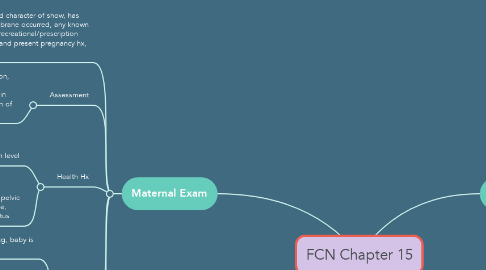
1. Maternal Exam
1.1. N/I: amount and character of show, has rupture of membrane occurred, any known drug allergies, recreational/prescription drug use, past and present pregnancy hx, birth plan
1.2. Assessment
1.2.1. VS, nature of contractions (freq, duration, intensity), rating of pain, labor preparations, urine specimen for protein and glucose, position and presentation of fetus
1.3. Health Hx
1.3.1. N/I: be patient because of pain level
1.3.1.1. documentation includes G/P, description of pregnancy, plans for labor, plans for child care, general health hx (drug use, past surgeries, hx disease, HTN, STD and HIV exposure, family hx
1.3.2. pelvic exam for general health, pelvic adequacy, cervical dilation stage, presentation and position of fetus
1.4. Show
1.4.1. Green: meconium staining, baby is stressed
1.4.2. Malodorous: potential infection
1.4.3. If membranes rupture during labor, assess FHR to check for cord prolapse
1.4.4. pH of show is tested and should be alkaline
1.5. Hook up to monitor
1.5.1. assess length, intensity and frequency of contractions and FHR
2. Response to Labor Danger Signs
2.1. Low or high BP
2.1.1. could indicate lack of oxygen to fetus, check FHR and report to physician
2.2. Maternal HR >100
2.2.1. can indicate hemorrhage and requires physician attention
2.3. decrease in contraction inertia and frequency
2.3.1. this can indicate uterine exhaustion, needs intervention
2.4. full bladder
2.4.1. make sure woman voids every 2 hrs because this prevents fetal head from descending under pelvic bone, damage to bladder can occur as well
2.5. Psychological danger
2.5.1. if extreme apprehension, stress, of fear occurs, can lead to oxygen depravation and internal hemorrhage
2.5.1.1. N/I: ask what is worrying her
3. Nursing Interventions
3.1. Third and fourth stages
3.1.1. massage fundus after delivery to encourage uterine contraction and prevent hemorrhage
3.1.2. Have oxytocin ready to encourage uterine contraction/prevent hemorrhage
3.1.2.1. obtain baseline BP because it can cause hypertension
3.1.3. monitor psychological changes during this time, assess for postpartum depression
3.1.4. take VS every 15 minutes
3.1.4.1. monitor for hemorrhage
3.1.4.1.1. if hemorrhaging, put in Trendelenburg position
3.1.5. encourage frequent bladder emptying
3.1.6. monitor lochia, frequently change mesh panties
3.1.7. reposition bed and offer clean, warm blanket, educate that shaking for 10-15 minutes PP is normal
3.1.8. fall risk
3.1.9. apply ice pack or cold washcloth to perineal area for pain
3.2. First Stage (takes ~12 hours)
3.2.1. Latent
3.2.1.1. N/I: if she is at the birth place, encourage breathing techniques and active moving around, last minute planning or alternative pain measurements
3.2.2. Active
3.2.2.1. cervical dilation occurs more rapidly, contractions last 40-60 sec every 3-5 min, rupture of membranes may occur
3.2.2.1.1. N/I: can be difficult as contractions grow stronger and more frequent. Address pain anxiety and fear, test pH of show
3.2.3. Transitional
3.2.3.1. contraction peak in intensity every 2-3 min for 60-70 seconds, max cervical dilation
3.2.3.1.1. N/I: understand patient may be irritable, extremely anxious, in intense pain
3.3. Second Stage
3.3.1. full dilation and cervical effacement occurs, crowning occurs and baby is delivered
3.3.1.1. N/I: assist with pushing, encourage alternative positions, encourage breathing techniques
4. Fetal Assessment
4.1. checking monitor for deceleration in fetal heart rate, meaning lack of oxygen to fetus, normal is 110-160 BPM monitor more frequently as labor progresses
4.1.1. N/I: reposition mother for deceleration

